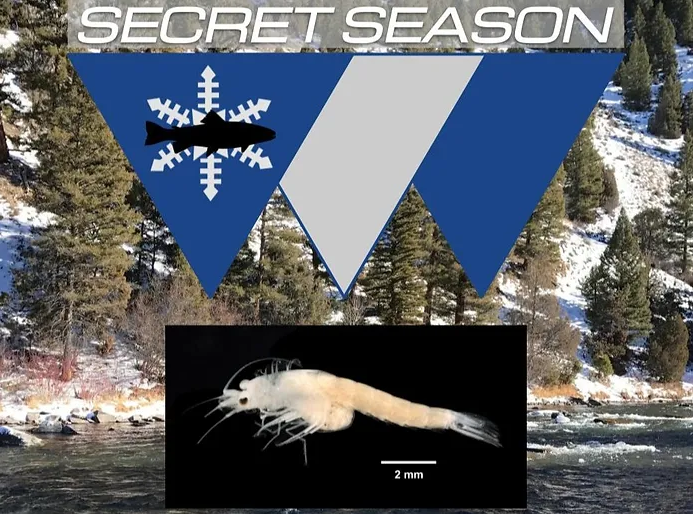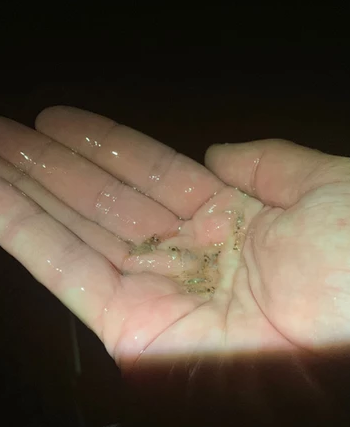History of the Mysis Fishery: Gaffe to Gold Medal
Gather around the fire and let me tell you a fly fishing tale of how mysis ended up feeding fish well downstream from the intended destination.

November 2023
Throughout the west, there are several tailwaters well known for growing large trout. Not just the above average trout, but truly gluttonous fish. How? These hogs are fed to the gills by mysis shrimp that spill downstream out of certain reservoirs. Many anglers flock to these tailwaters for their chance at glory, and these rivers are generally well received by the angling community. But how these mysis ended up feeding tailwater trout is largely a lucky outcome from a widespread management blunder.
As we’re approaching the depths of winter (not to mention the heart of the mysis season), gather around the fire and let me tell you the tale of how mysis ended up feeding fish well downstream from the intended destination.
By the time the mysis shrimp was discovered in 1862 it was already on its way to extinction. This relict species was once widespread across Canada and the northern United States, but populations became isolated as glaciers receded. After hatchery programs exploded onto the scene around the turn of the century, fisheries managers were searching for a forage base to support stocking efforts in coldwater (oligotrophic) lakes, where temperatures limited fish productivity. The mysis shrimp was proposed as a forage source in 1939 by Canadian scientists to support the commercial Lake Whitefish industry in Lake Okanagan. It was known at this time that mysis preferred low light conditions and would favor lake bottoms, not highly available to species like Kokanee Salmon or Rainbow Trout. However, it wasn’t until 1949 that mysis shrimp stormed their first beach, planted in Kootenay Lake, British Columbia, to support rainbow trout. --That is not a typo.– By the 1950s, the idea of mysis introduction had spread. The Swedish began feeding their reservoir Arctic Char with mysis, and in the United States, Twin Lakes, Colorado was stocked to support Lake Trout populations, a similar situation to Great Lakes systems where both Lake Trout and mysis are native. In the 1960s, other states like Utah, New York, and Wisconsin all considered improving their Lake Trout fisheries with mysis introductions.
Many of these stocking plans, now built around supporting Lake Trout fisheries, seemed justified. But remember that early introduction into Kootenay lake? Well, Kootenay was full of surprises. In 1964, the same scientist (Peter Larkin) responsible for the original mysis introduction at Kootenay lake published an article touting the success of his mysis introduction, observing a noticeable increase in both Kokanee size and catch rates. This ‘success story’ for Kokanee salmon spread mysis mania throughout North America. Lakes in Canada, Idaho, Montana and California were now harboring mysis shrimp to improve Kokanee stocks. Even though it took years to establish a mysis population base in many of these lakes, some signs of improvement were being reported, until the 1970s when Kokanee populations started crashing. Upon further investigations, scientists started to (again) realize that mysis shrimp aren’t actually available forage to Kokanee salmon. Kokanee salmon tend to favor open water, high in the water column during the day, when mysis shrimp are deep out of the reach of penetrating light. It isn’t until nightfall when mysis emerge from the depths to feed, which just happens to be when Kokanee are least active. What's worse, scientists started to recognize that both Kokanee and mysis were actually competing for the same food, zooplankton. Finally by 1980, a freeze on mysis introductions was finally proposed.
Interestingly, the early work on mysis natural history was correct, and whether or not that work was well understood, there were indicators that mysis would not likely support lake populations of Rainbow Trout or Kokanee Salmon. So what the hell was happening in Kootenay lake that grew the Kokanee so large? Apparently, a unique upwelling in the western arms of the lake relocated mysis from the depths to higher in the water column, making them available for diurnal Kokanee feeding.
But the ecological effects of mysis introduction in most other lakes were already set into motion, and no lake exemplifies the cascading fallout better than the Kokanee crash in Flathead Lake, Montana. To start, mysis weren’t even introduced into Flathead Lake. They were originally introduced upstream in Swan, Ashley, and Whitefish Lakes, and drifted downstream into Flathead. Enough made it to cause a mysis populations spike in 1985, and then by 1987, zero Kokanee were caught. Not only were Kokanee out competed by mysis foraging for zooplankton, but the mysis shrimp also provided forage for juvenile deep dwelling Lake Trout. This grew Lake Trout into large piscivorous hunters, leading to additional pressures on Kokanee populations, as Lake Trout prey. The Kokanee were getting eaten out of house and home on both ends of the food chain. Further, these well fed Lake Trout out competed native Bull Trout, eventually leading to a federal Threatened and Endangered Species listing for Bull Trout in 1998. Kokanee, once such prolific spawners out of Flathead Lake that bald eagles and mammals would congregated during the fall spawning migration, were now forced to disperse due to the lack of salmon. Even today lake managers are still struggling to control the Lake Trout populations in Flathead Lake.
In Colorado, where multiple famous mysis tailwaters are located, mysis introduction into Lake Dillon, Taylor Park Reservoir, and Ruedi Reservoir didn’t happen until the 1970s. Even then, the benefits to downstream trout weren't known. But now savvy anglers recognize how mysis benefit tailwater trout. The Colorado state length record for Rainbow trout is 40.25”, caught below Taylor Park Reservoir, and the record Snake River Cutthroat measured at 31” from the same tailwater. So the idea of a mysis fishery has changed, now seen a prized tailwater recreational destination.

But like Flathead Lake, Colorado wildlife officials are still struggling to fight off the cascading effects set in place by mysis. At Lake Dillon, following the ways of the Scandanavian scientists of the 1950s, Arctic Char have now been introduced as a means to regulate mysis shrimp, as both species favor the deep cold water of the lake. Nonetheless, tailwater trout behind these reservoirs thrive.
It’s hard to think that such blunders could have any positive outcomes, but the fly fishing world has been changed forever thanks to the sordid introduction of mysis shrimp throughout North America. A rare phenomenon in the history of species introduction, where many blunders are found. See Asian Carp, Zebra Mussels, Cane Toad, Snakehead, Brown Tree Snake, and the list goes on...
Sources:
- Chelsi Moy, Flathead Lake study points to shrimp as cause of decline in biological diversity, Missoulian, Jan 16, 2011, Access Date: 1/3/2020.
- Foster, A.M., A.J. Benson, and M. Cannister, 2020, Mysis diluviana Loven, 1862: U.S. Geological Survey, Nonindigenous Aquatic Species Database, Gainesville, FL, https://nas.er.usgs.gov/queries/FactSheet.aspx?SpeciesID=1142, Revision Date: 5/2/2018, Access Date: 11/13/2019.
- Leif Fredrickson, Bio-Invasions and Bio-Fixes: Mysis Shrimp Introductions in the Twentieth Century, Environment and History 23, no. 2, May 2017, 285-320.
- Leif Fredrickson, The Mysis Crisis: How Fisheries Scientists Turned an Isolated Shrimp into an "Invasive Species", Enviro-History.com, March 16, 2018.
- Records By Length, Colorado Parks & Wildlife, https://cpw.state.co.us/learn/Pages/RecordsbyLength.aspx, Access Date: 12/5/2019.


